Rust Family Foundation: Archaeology Grants Program
Obsidian Trade Networks and the Impact of Wari State Expansion in Cusco, Peru
Principal Investigator: Véronique Bélisle, Ph.D.
Assistant Professor of Anthropology, Millsaps College
This research project evaluates how ancient state expansion affected the economy of local communities. More specifically, th
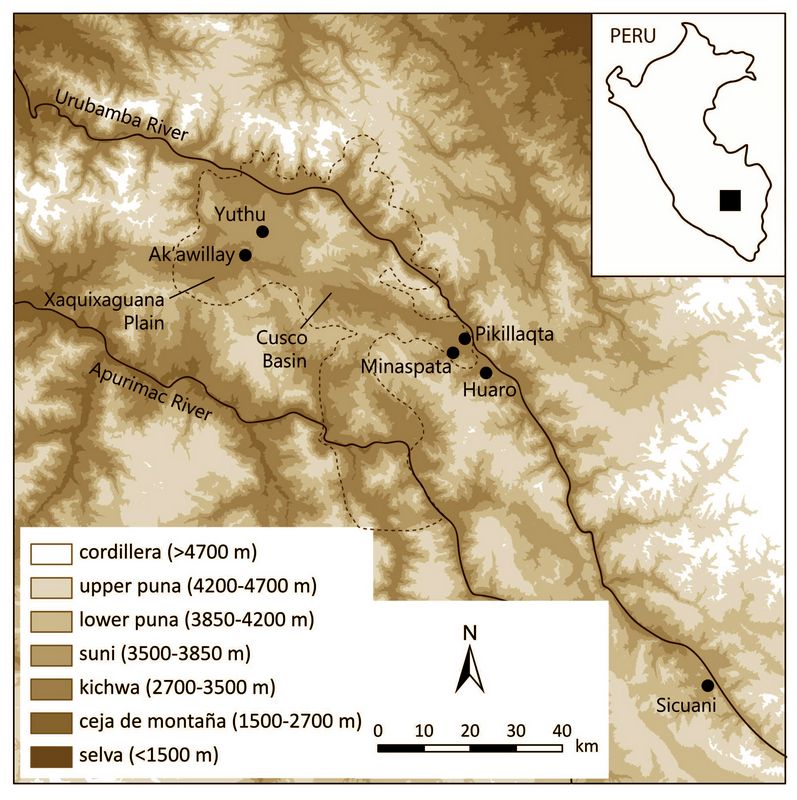 e project
investigates the impact of Wari state expansion on trade networks in
the Cusco region of southern Peru (fig,1) during the Middle Horizon
(600-1000 CE). In the Andes, the Middle Horizon was
characterized by the rise and expansion of the Wari state and the
establishment of several colonies in the Peruvian highlands.
e project
investigates the impact of Wari state expansion on trade networks in
the Cusco region of southern Peru (fig,1) during the Middle Horizon
(600-1000 CE). In the Andes, the Middle Horizon was
characterized by the rise and expansion of the Wari state and the
establishment of several colonies in the Peruvian highlands. Fig.1: Map of the Cusco region showing the Wari colony at Pikillaqta and Huaro, the local center of Ak’awillay, other sites mentioned in the text, and the surveyed area (dotted line).
Obsidian data provide an independent line of evidence with which to assess Wari impact in Cusco during the Middle Horizon. Since each obsidian source has a unique chemical composition, obsidian objects can be traced to their precise location of origin. Three types of high-quality obsidian have been identified as the main sources exploited in prehispanic Peru –Alca, Chivay, and Quispisisa – in addition to a series of minor sources whose obsidian appears less frequently in excavated contexts (fig.2) (e.g., Burger et al. 1998a, 1998b, 2000, 2016; Eerkens et al. 2010; Glascock and Giesso 2012; Tripcevich 2010; Vaughn and Glascock 2005; Williams et al. 2012).
Burger and colleagues (2000), who in a seminal study present obsidian provenience from sites of all periods in southern Peru and northern Bolivia, argued
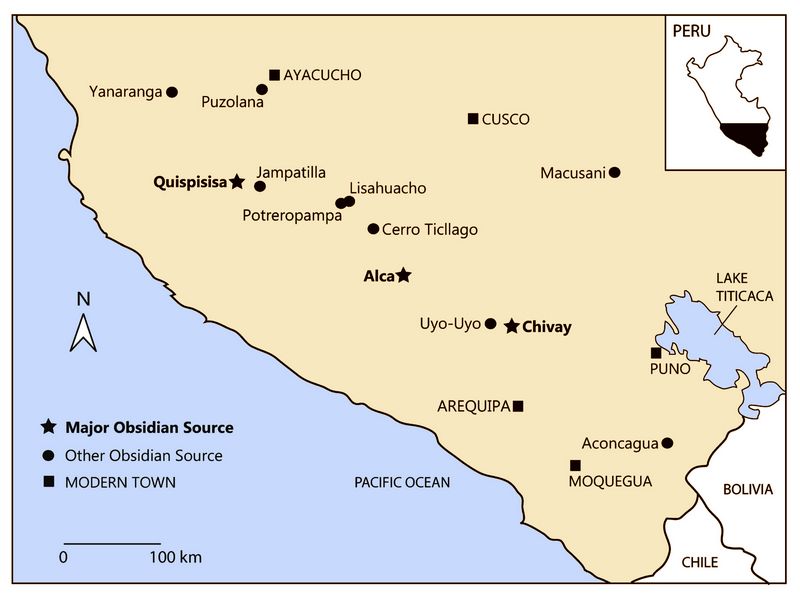 that the Wari introduced considerable changes
in obsidian procurement patterns in Cusco during the Middle Horizon.
They also identified obsidian from an unknown source that they
hypothesized to be in the province of Chumbivilcas in the southern part
of the Department of Cusco.
that the Wari introduced considerable changes
in obsidian procurement patterns in Cusco during the Middle Horizon.
They also identified obsidian from an unknown source that they
hypothesized to be in the province of Chumbivilcas in the southern part
of the Department of Cusco. Fig 2: Map of southern Peru showing the location of known obsidian sources.
A productive way of assessing Wari economic impact is to document changes to trade networks through time and evaluate the role of Wari colonists or authorities in these changes. Obsidian is particularly well suited for such a study since it was widely distributed in the Andes very early on (e.g., Rademaker et al. 2014; Tripcevich et al. 2012) and discoveries of the last few decades allow to trace it to its exact point of origin (Burger et al. 1998a, b, c; Burger and Glascock 2000a, b; Burger et al. 2006; Craig et al. 2010; Glascock et al. 2007; Rademaker et al. 2013), thereby allowing the reconstruction of ancient trade networks. This project thus investigates obsidian trade networks before and during Wari presence in Cusco to document Wari impact on local economies and evaluate how (and if) the arrival of Wari colonists in the area affected exchange networks. This research provides valuable data with which to understand the degree of penetration of early states and the extent to which local populations maintained power over economic activities.
Previous Research at the site.
Recent research conducted by Bélisle has identified obsidian artifacts in excavated contexts in Cusco whose source had not been identified. Another project, conducted by the Peruvian Ministry of Culture in Chumbivilcas, reported an abundance of obsidian in the area, making it highly likely that an outcrop is nearby. The current project’s objective was to locate and document this new outcrop in Chumbivilcas and verify which artifacts correspond to this source. Knowing what artifacts are sourced to this obsidian outcrop allowed the PI to (1) trace exchange networks; (2) examine change in obsidian procurement through time and space; and (3) evaluate how (and if) the arrival of Wari colonists in Cusco affected the flow of goods.
The Accobangara obsidian outcrop is located in the district of Santo Tomás, province of Chumbivilcas, on two hills between 4349 and 4486 meters above sea level (masl). It is at the very southern tip of the Department of Cusco, close to the Department of Arequipa (fig.3). It is in a very remote area near the village of Iñapata. To get to Accobangara, one first travels south from Cusco to the town of Velille, going through Sicuani and Espinar, a six-hour trip by car.
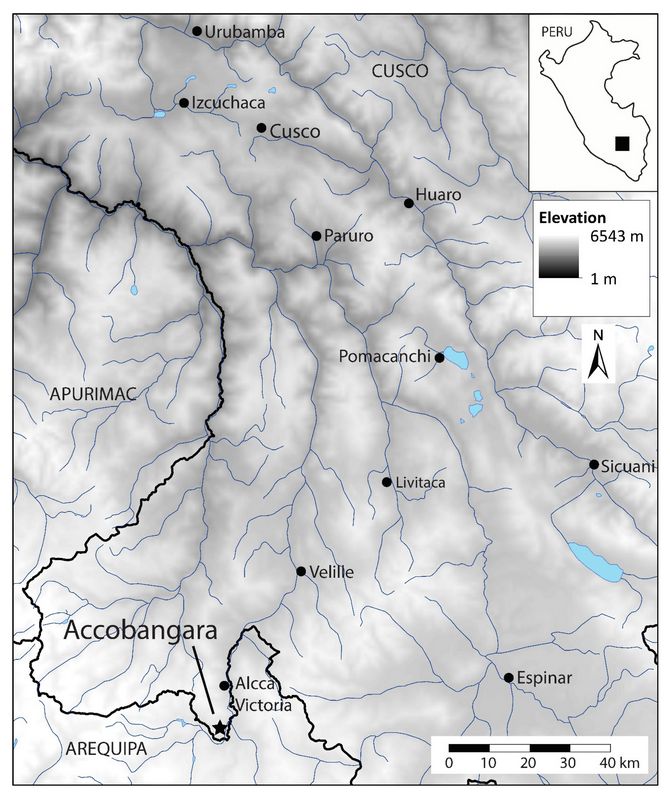 From the
town of Velille, one then drives south for two more hours in rough
terrain. The road first follows the Velille River, passing the villages
of Esquina and Alcca Victoria, after which one goes west, driving
through the high mountain pass of Apacheta (4679 masl) before arriving
to the small village of Iñapata (4459 masl). From Iñapata, ones walks
southeast for approximately 30 minutes to the Accobangara hills.
From the
town of Velille, one then drives south for two more hours in rough
terrain. The road first follows the Velille River, passing the villages
of Esquina and Alcca Victoria, after which one goes west, driving
through the high mountain pass of Apacheta (4679 masl) before arriving
to the small village of Iñapata (4459 masl). From Iñapata, ones walks
southeast for approximately 30 minutes to the Accobangara hills.Fig.3: Map of the southern part of the Department of Cusco showing the location of the new Accobangara obsidian outcrop.
The area is characterized by a series of hills on a high plateau surrounded by the Cacansamayo River. This river is a tributary of the Velille River, itself a tributary of the Apurimac River to the north. The Accobangara surroundings include small villages, hamlets, and dispersed family farms. Economic activities in this high puna are centered on camelid herding (both llama and alpacas). The area has many bofedales (wetlands) and is near several ponds, both of which could have attracted herders in the past.
2019 Funded Research Project (RFF-2019-105)
Project Goals
Goal 1: Document a new obsidian outcrop in the province of Chumbivilcas, Cusco, Peru. To reach this goal, the team traveled to the province of Chumbivilcas and located the Accobangara obsidian source near the village of Iñapata, south of the town of Velille. This was done with the participation of three Peruvian archaeologists, all of whom worked in Chumbivilcas and are familiar with the area: Hubert Quispe-Bustamante, Sofía Florencia Venero Molina, and Prof. José Luis Tovar Cayo.
Goal 2: Inventory the artifacts that were made from the Chumbivilcas obsidian.
The 30 samples of Accobangara obsidian were brought to the United States for geochemical analysis. Millsaps College’s XRF spectrometer was used to obtain the preliminary geochemical composition of the samples, after which the samples were sent to the University of Missouri Research Reactor (MURR) for neutron activation analysis. It was then possible to compare the geochemical composition of the Accobangara outcrop with that of obsidian artifacts found at archaeological sites.
Goal 3: Train an undergraduate student in field and lab methods.
A senior undergraduate student from Millsaps College, Matthew Brown, joined the PI and participated in several steps of the research in Peru and in the United States. This provided Brown with an invaluable experience and a set of skills that he will be able to apply to his own dissertation research while in graduate school at the University of Michigan. Brown traveled to Chumbivilcas and participated in data collection and geochemical analysis. He will also be included in the publication.
Methodology:
1. Survey and sample collection.
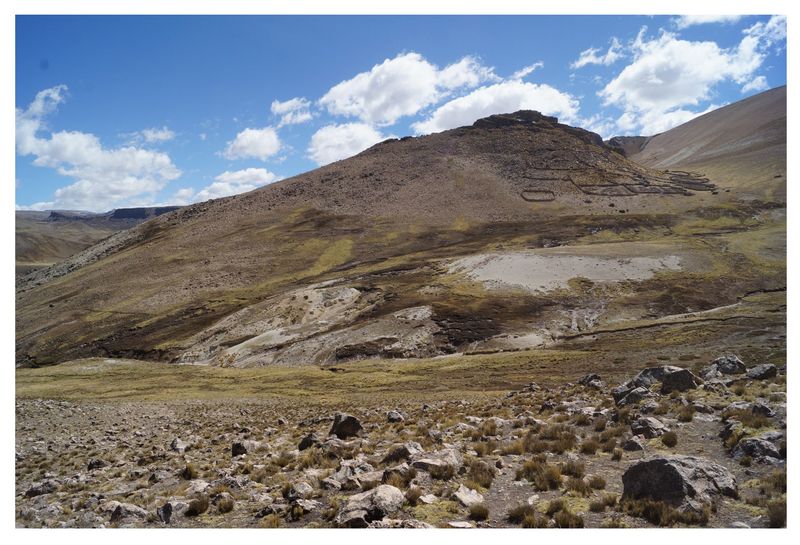 Within the Accobangara obsidian outcrop, the team identified obsidian deposits over an area of 1.35 km
(northwest to southeast) by 0.5 km (southwest to northeast) (0.7 km2),
spanning two hills (Figures 4 and 5). However, it is possible that the
area is larger; snow and hazardous driving conditions obliged the team
to return to Velille.
Within the Accobangara obsidian outcrop, the team identified obsidian deposits over an area of 1.35 km
(northwest to southeast) by 0.5 km (southwest to northeast) (0.7 km2),
spanning two hills (Figures 4 and 5). However, it is possible that the
area is larger; snow and hazardous driving conditions obliged the team
to return to Velille. Fig.4: The first of two hills with Accobangara obsidian. Obsidian was found above the corrals visible on the right.
The obsidian from Accobangara is of high quality and produces a conchoidal fracture, although its nodules are relatively small and measure from one to 10 cm. This indicates that the tools produced from this obsidian were smaller than 10 cm in length. The obsidian is black in color.
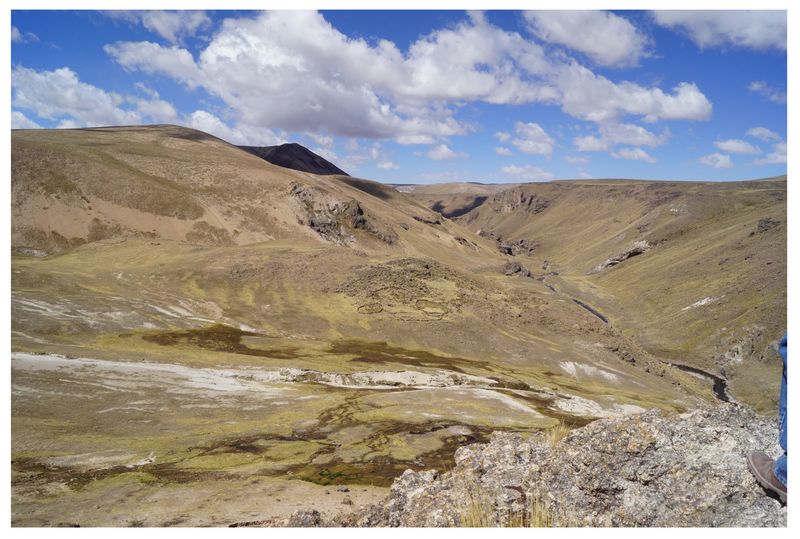
Fig.5: The second of two hills with Accobangara obsidian. Obsidian was found near the rock above the corrals visible in the middle of the photograph. The Cacansamayo River is on the right.
The surface of the Accobangara hills contains a large number of nodules that are embedded in volcanic tuff and ash (fig.6). No débitage or hammerstones were present on the surface and only two cores were identified, suggesting that obsidian was not processed in situ. In addition, the area did not include structures, workshops, or other artifacts such as pottery. However, the nearby village of Iñapata is next to an ancient settlement that contains circular structures, domestic pottery, and a large number of obsidian flakes. The presence of pottery suggests that this site dates to after the Archaic (which ended ca. 2200 BCE), but no radiocarbon dates are available to date the site more precisely. The presence of obsidian flakes and the fact that the nodules from Accobangara are relatively small means that they could easily have been transported to this site for processing.
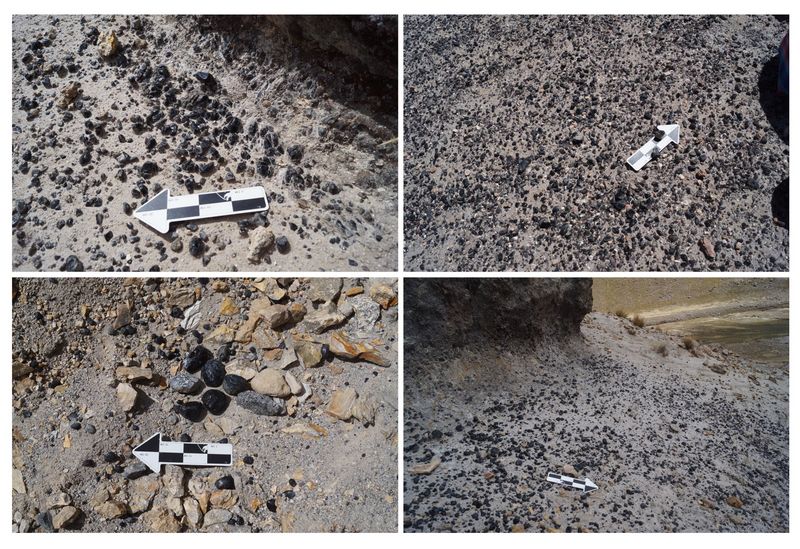
Fig.6: Accobangara obsidian in situ, showing the high density of relatively small nodules measuring between one and 10 cm in length.
Although going through Espinar is the best route to reach Velille today due to the nearby mines that encouraged the Peruvian government to build good roads, it is not the only one. In the past, people could have used at least two other routes. The first goes through Pomacanchi and from there one goes northeast to reach the Vilcanota Valley. This road passes through Huaro, therefore going through the Wari colony. The other route completely avoids the Wari colony and links Velille north to Paruro and then to the Cusco Basin.
Once the team located the obsidian outcrop, we recorded GPS coordinates and elevation of Accobangara in addition to details about the surrounding environment and the proximity to neighboring towns and rivers. We surveyed the deposits and documented the outcrop’s size (area), the quality and color of its obsidian, and the size of the nodules present on the surface. We also verified the existence of tools and debris on the surface, which could indicate that obsidian was processed on-site. The team finally collected 30 obsidian samples with their respective GPS coordinates. Since the outcrop is divided into two different sections, we took samples from each section to test for the presence of subsources within the outcrop. The samples were bagged with provenience tags and brought back to the lab in the city of Cusco.
2. Analysis of samples.
The 30 geological samples from Accobangara were sent to the University of Missouri Research Reactor (MURR) for neutron activation analysis (NAA) under the supervision of Dr. Michael Glascock. In addition to performing NAA, energy dispersive X-ray fluorescence (XRF) was conducted to make the source data available for comparisons by either analytical method. The results show that obsidian from Accobangara can be differentiated from other Peruvian sources by both XRF and NAA using a number of different elements.
The samples were cut in half with a small rock saw prior to analysis. One half was used for XRF and the other half was used to produce a sample for NAA. The samples for XRF were measured on a Thermo Quantx ARL spectrometer operating at 35 kilovolts. The spectrometer was calibrated for obsidian by analyzing a suite of 40 geological obsidians analyzed by NAA, XRF and inductively coupled plasma mass spectrometry (ICP-MS).
 The samples for NAA
were reduced to a number of smaller fragments. Two aliquots were
prepared—one for short irradiations (100 mg) and one for long
irradiations (200 mg). The short irradiation samples were irradiated
for five seconds in a neutron flux of 8x1013 neutrons cm-2 s-1. After
decaying for 25 minutes, the samples were counted for 12 minutes each
on a high-purity germanium detector. This allows measurement of the
short-lived elements of Al, Ba, Cl, Dy, K, Mn, and Na. The long
irradiation samples were irradiated for 48 hours in a neutron flux of
6x1013 neutrons cm-2 s-1 and followed by two decays and counts.
The samples for NAA
were reduced to a number of smaller fragments. Two aliquots were
prepared—one for short irradiations (100 mg) and one for long
irradiations (200 mg). The short irradiation samples were irradiated
for five seconds in a neutron flux of 8x1013 neutrons cm-2 s-1. After
decaying for 25 minutes, the samples were counted for 12 minutes each
on a high-purity germanium detector. This allows measurement of the
short-lived elements of Al, Ba, Cl, Dy, K, Mn, and Na. The long
irradiation samples were irradiated for 48 hours in a neutron flux of
6x1013 neutrons cm-2 s-1 and followed by two decays and counts. Table 1: Summary Statistics for Accobangara obsidian by XRF in parts per million
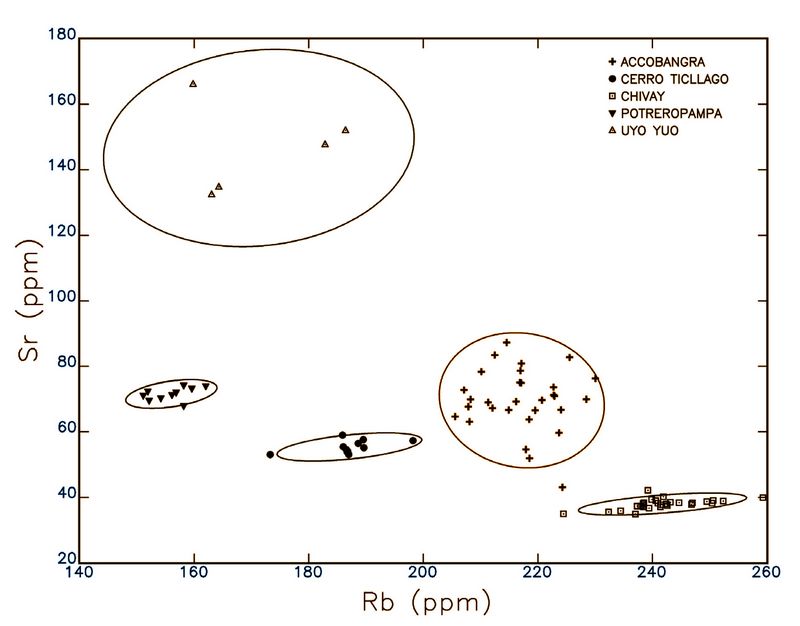
After seven days, the first count was conducted for 30 minutes to measure several medium-lived elements: La, Lu, Nd, Sm, U, and Yb. After 21 days, a second count was conducted for 2.5 hours to measure the long-lived elements: Ce, Co, Cs, Eu, Fe, Hf, Rb, Sb, Sc, Sr, Ta, Tb, Th, Zn, and Zr.
Fig.7: Scatterplot of Rb versus Sr from XRF for sources most similar to Accobangara.
The means and standard deviations for the 30 Accobangara samples analyzed by XRF are listed in Table 1. Fig. 7 shows a scatterplot based on the elements Rb and Sr from XRF comparing the Accobangara obsidian to several of the most similar sources in Peru.
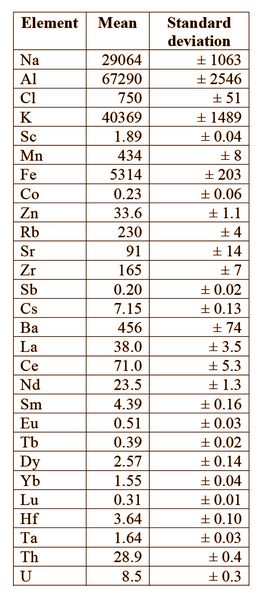 Table 2 (left): Summary statistics for Accobangara
Table 2 (left): Summary statistics for Accobangaraobsidian by NAA in parts per million.
.
The means and standard deviations for the 30 Accobangara samples analyzed by NAA are listed in Table 2. Fig.8 shows a scatterplot based on the elements Cs and Hf from NAA comparing the Accobangara obsidian to several of the most similar sources in Peru.
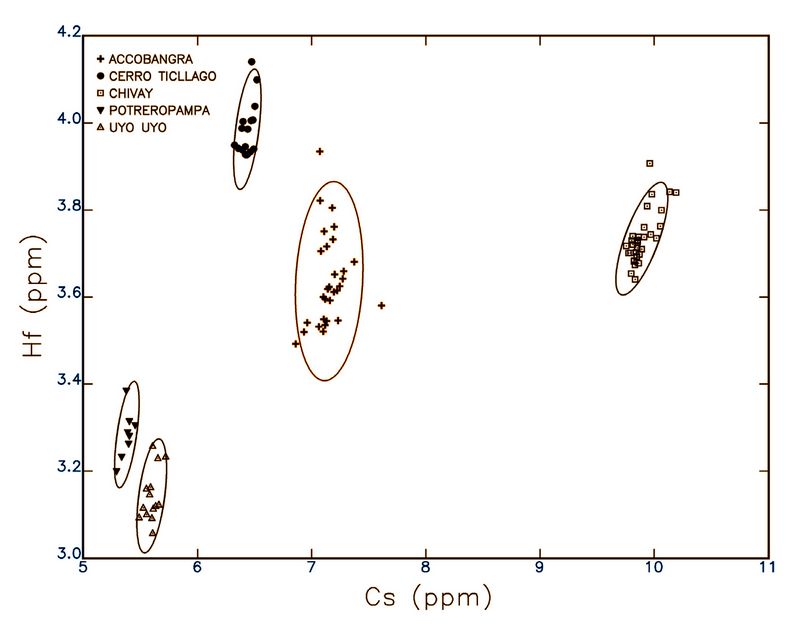
Fig.8 (right): Scatterplot of Cs versus Hf from NAA for sources most similar to Accobangara.
Results from XRF and NAA determined that the Accobangara outcrop is chemically homogenous; no subsources were identified. Furthermore, results indicate that XRF spectrometry is a reliable method to differentiate the Chumbivilcas source from other obsidian outcrops in the Andes. This is particularly important since many archaeologists today rely on portable equipment such as XRF spectrometers to source obsidian artifacts, which could only be exported to the United States with difficulty (or not at all in the case of worked pieces and tools).
3. Comparison with Artifacts.
The Accobangara data from XRF and NAA were then compared against the elemental composition of previously analyzed obsidian artifacts from Peru. The artifacts used in this study are those already scanned by Bélisle and those that have been analyzed by MURR over the years. If the geochemical composition of artifacts matches that of the Accobangara outcrop, then it is possible to conclude that these artifacts were made from this obsidian.
At this time, there are no artifacts in the MURR database that appear to be related to the Accobangara source. However, there are 10 artifacts previously scanned by Bélisle that seem to have been made from the Accobangara obsidian. These artifacts are from the sites of Yuthu (pre-Middle Horizon), Minaspata (pre-Middle Horizon contexts), and Ak’awillay (Middle Horizon contexts) (see fig.1). The provenience of these obsidian artifacts was unknown until now. Their chemical composition does not coincide with that of any other known obsidian source in Peru, but it does match the elemental composition of Accobangara.
Conclusions
The contributions of this project to the field of Andean archaeology are fourfold. First, it was possible to locate and document a new obsidian outcrop in the southern highlands of Peru. This source was, until now, completely unknown to archaeologists. Results indicate that Accobangara obsidian is of high quality, although its nodules are relatively small and the outcrop’s location is fairly remote.
Second, this project documented the geochemical composition of the Accobangara obsidian through X-Ray fluorescence spectrometry and neutron activation analysis. Results indicate that this source is chemically different from all other known obsidian outcrops in the Andes. In addition, analyses demonstrate that both XRF and NAA can be used to discriminate between the Accobangara source and other obsidian outcrops in the Andes. This will allow other archaeologists to use portable XRF spectrometers to identify artifacts from the Accobangara source.
Third, the project demonstrated the use of this obsidian in the past. So far, only artifacts from the Cusco region have been sourced to Accobangara. Despite its quality, this obsidian was used less often than other major sources in the Andes, perhaps due to its remote location or to the small size of its nodules. It might have been an outcrop whose use was limited to the surrounding regions of Cusco and Arequipa, although future obsidian provenience studies could identify more artifacts made from Accobangara obsidian.
Finally, the data gathered in this project allow an evaluation of the degree of Wari control over regional economic networks and an assessment of Wari impact on local communities. By identifying which obsidian artifacts came from Accobangara, this project was able to evaluate the flow of goods through time and assess any disruptions in this network that could be due to Wari presence in Cusco. The presence of Accobangara obsidian in pre-Middle Horizon and Middle Horizon contexts at excavated sites in the Cusco region suggests that Wari had limited impact on obsidian exchange networks. Since Accobangara obsidian appears at sites of all periods, it appears that the procurement of this type of good was independent from Wari exchange networks and that its circulation through local networks persisted despite Wari presence. In other words, Wari colonists did not interrupt the flow of goods in the region upon their arrival. This hints at the limited influence of Wari colonists over the manufacture and distribution of local commodities and suggests that instead of being reoriented towards Ayacucho, regional trade was lively and continued to flourish despite Wari presence.
These data provide insights on the persistence of regional trade networks in a context of state colonization. Instead of the previously hypothesized deep economic changes among local populations, including the disruption and reorientation of trade networks to facilitate state control over exotic goods, data from this project demonstrate that this is not always the case. Expanding states do not necessarily penetrate very deeply into local affairs, and local communities can continue to engage in regional economic activities, with little impact on preexisting trade networks.
Ongoing Plans
The expected outcome of this research project is the publication of a co-authored article in a peer-reviewed journal. The manuscript will describe the Accobangara outcrop, the results of the geochemical analyses, and the comparison with excavated artifacts from the Cusco region. The PI plans to conduct more fieldwork in Chumbivilcas to gather obsidian artifacts from the surface of known archaeological sites. The PI will also contact colleagues in the United States who have obsidian artifacts whose source is unknown. The comparison of their geochemical composition to that of the Accobangara outcrop will determine if these artifacts came from Chumbivilcas.
Bibliography:
Bauer, B.S., 2004. Ancient Cuzco: Heartland of the Inca. Austin: University of Texas Press.
Bélisle, V., 2014. Early Intermediate Period and Middle Horizon Settlement Patterns in the Xaquixaguana Region, in Regional Archaeology in the Inca Heartland: The Hanan Cuzco Surveys, ed. R.A. Covey. Ann Arbor: University of Michigan Museum of Anthropology, 77-91.
Bélisle, V., 2015. Understanding Wari State Expansion: A "Bottom-Up" Approach at the Village of Ak'awillay, Cusco, Peru. Latin American Antiquity, 26(2), 180-99.
Bélisle, V. & R.A. Covey, 2010. Local Settlement Continuity and Wari Impact in Middle Horizon Cusco, in Beyond Wari Walls: Regional Perspectives on Middle Horizon Peru, ed. J. Jennings. Albuquerque: University of New Mexico Press, 79-95.
Bélisle, V. & V. Galiano Blanco, 2010. Ak’awillay: un pueblo autónomo durante la colonización wari en el Cusco. Revista Andina, 50, 141-73.
Burger, R.L., F. Asaro, G. Salas & F. Stross, 1998a. The Chivay Obsidian Source and the Geological Origin of Titicaca Basin Type Obsidian Artifacts. Andean Past, 5, 203-23.
Burger, R.L., F. Asaro, P. Trawick & F. Stross, 1998b. The Alca Obsidian Source: The Origin of Raw Material for Cuzco Type Obsidian Artifacts. Andean Past, 5, 185-202.
Burger, R.L., C.M. Bencic & M.D. Glascock, 2016. Obsidian procurement and cosmopolitanism at the Middle Horizon settlement of Conchopata, Peru. Andean Past, 12, 21-44.
Burger, R.L., F.A. Fajardo Rios & M.D. Glascock, 2006. Potreropampa and Lisahuacho obsidian sources: geological origins of Andahuaylas A and B type obsidians in the province of Aymaraes, Department of Apurimac, Peru. Ñawpa Pacha, 28, 109-27.
Burger, R.L. & M.D. Glascock, 2000a. Locating the Quispisisa obsidian source in the Department of Ayacucho, Peru. Latin American Antiquity, 11(3), 219-40.
Burger, R.L. & M.D. Glascock, 2000b. The Puzolana Obsidian Source: Locating the Geologic Source of Ayacucho Type Obsidian. Andean Past, 6, 289-307.
Burger, R.L., K.L. Mohr Chávez & S.J. Chávez, 2000. Through the Glass Darkly: Prehispanic Obsidian Procurement and Exchange in Southern Peru and Northern Bolivia. Journal of World Prehistory, 14(3), 267-362.
Burger, R.L., J.K. Schreiber, M.D. Glascock & J. Ccencho, 1998c. The Jampatilla Obsidian Source: Identifying the Geological Source of Pampas Type Obsidian Artifacts from Southern Peru. Andean Past, 5, 225-39.
Covey, R.A., 2006. How the Incas Built Their Heartland: State Formation and the Innovation of Imperial Strategies in the Sacred Valley, Peru, Ann Arbor: University of Michigan Press.
Covey, R.A., 2014. Local Developments in the Sacred Valley and Responses to Wari Colonization, in Regional Archaeology in the Inca Heartland: The Hanan Cuzco Surveys, ed. R.A. Covey. Ann Arbor: University of Michigan Museum of Anthropology, 93-108.
Covey, R.A., B.S. Bauer, V. Bélisle & L. Tsesmeli, 2013. Regional Perspectives on Wari State Influence in Cusco, Peru (c. AD 600-1000). Journal of Anthropological Archaeology, 32, 538-52.
Craig, N., R.J. Speakman, R.S. Popelka-Filcoff, M.S. Aldenderfer, L.F. Blanco, M.B. Vega, M.D. Glascock & C. Stanish, 2010. Macusani obsidian from southern Peru: A characterization of its elemental composition with a demonstration of its ancient use. Journal of Archaeological Science, 37, 569-76.
Eerkens, J.W., K.J. Vaughn, M. Linares-Grados, C. Conlee, J.K. Schreiber, M.D. Glascock & N. Tripcevich, 2010. Spatio-temporal patterns in obsidian consumption in the Southern Nasca Region, Peru. Journal of Archaeological Science, 37, 825-32.
Glascock, M.D. & M. Giesso, 2012. New Perspectives on Obsidian Procurement and Exchange at Tiwanaku, Bolivia, in Obsidian and Ancient Manufactured Glasses, eds. I. Liritzis & C. Stevenson. Albuquerque: University of New Mexico Press, 86-96.
Glascock, M.D., R.J. Speakman & R.L. Burger, 2007. Sources of Archaeological Obsidian in Peru: Descriptions and Geochemistry, in Archaeological Chemistry: Analytical Techniques and Archaeological Interpretation, eds. M.D. Glascock, R.J. Speakman & R.S. Popelka-Filcoff. Washington DC: American Chemical Society, 522-52.
Glowacki, M., 2002. The Huaro Archaeological Site Complex: Rethinking the Huari Occupation of Cuzco, in Andean Archaeology I: Variations of Sociopolitical Organization, eds. W.H. Isbell & H. Silverman. New York: Kluwer Academic, 267-85.
Glowacki, M., 2005. Dating Pikillacta, in Pikillacta: The Wari Empire in Cuzco, ed. G.F. McEwan. Iowa City: University of Iowa Press, 115-24.
Glowacki, M. & G.F. McEwan, 2002. Pikillacta, Huaro y la Gran Región del Cuzco: Nuevas Interpretaciones de la Ocupación Wari en la Sierra Sur, in Huari y Tiwanaku: Modelos vs. Evidencias, eds. P. Kaulicke & W.H. Isbell. Boletín de Arqueología PUCP No. 5. Lima, Peru: Fondo Editorial de la Pontificia Universidad Católica del Perú, 31-49.
McEwan, G.F. (ed.) 2005. Pikillacta: The Wari Empire in Cuzco, Iowa City: University of Iowa Press.
Morrison, K.D. & L.L. Junker, 2002. Forager-Traders in South and Southeast Asia: Long-Term Histories. Cambridge: Cambridge University Press.
Rademaker, K., M.D. Glascock, B. Kaiser, D. Gibson, D.R. Lux & M.G. Yates, 2013. Multi-technique geochemical characterization of the Alca obsidian source, Peruvian Andes. Geology, 41(7), 779-82.
Rademaker, K., G. Hodgins, K. Moore, S. Zarrillo, C. Miller, G.R.M. Bromley, P. Leach, D.A. Reid, W.Y. Álvarez & D.H. Sandweiss, 2014. Paleoindian settlement of the high-altitude Peruvian Andes. Science, 346, 466-9.
Schreiber, K.J., 2005. Imperial Agendas and Local Agency: Wari Colonial Strategies, in The Archaeology of Colonial Encounters: Comparative Perspectives, ed. G.J. Stein. Santa Fe: School of American Research Press, 237-62.
Skidmore, M., 2014. Wari Power, Wari People: Building Critical Perspectives on State Expansion at Hatun Cotuyoc, Huaro, Peru. PhD Dissertation, Department of Anthropology, Southern Methodist University, Dallas.
Tripcevich, N., 2010. Exotic goods, Chivay obsidian, and sociopolitical change in the South-Central Andes, in Trade and Exchange: Archaeological Studies from History and Prehistory, eds. C. Dillian & C. White. New York: Springer, 59-73.
Tripcevich, N., J.W. Eerkens & T.R. Carpenter, 2012. Obsidian hydration at high elevation: Archaic quarrying at the Chivay source, southern Peru. Journal of Archaeological Science, 39, 1360-7.
Vaughn, K.J. & M.D. Glascock, 2005. Exchange of Quispisisa obsidian in Nasca: New evidence from Marcaya. Andean Past, 7, 93-110.
Williams, P.R., L. Dussubieux & D.J. Nash, 2012. Provenance of Peruvian Wari Obsidian: Comparing INAA, LA-ICP-MS, and Portable XRF, in Obsidian and Ancient Manufactured Glass, eds. I. Liritzis & C. Stevenson. Albuquerque: University of New Mexico Press, 75-85.
Zapata Rodríguez, J., 1997. Arquitectura y Contextos Funerarios Wari en Batan Urqu, Cusco, in: La Muerte en el Antiguo Perú: Contextos y Conceptos Funerarios, ed. P. Kaulicke. Lima, Peru: Fondo Editorial de la Pontificia Universidad Católica del Perú, 165-206.
Recent Foundation grants: general Archaeology Grants Program w/map
Copyright © 2022 Rust Family Foundation